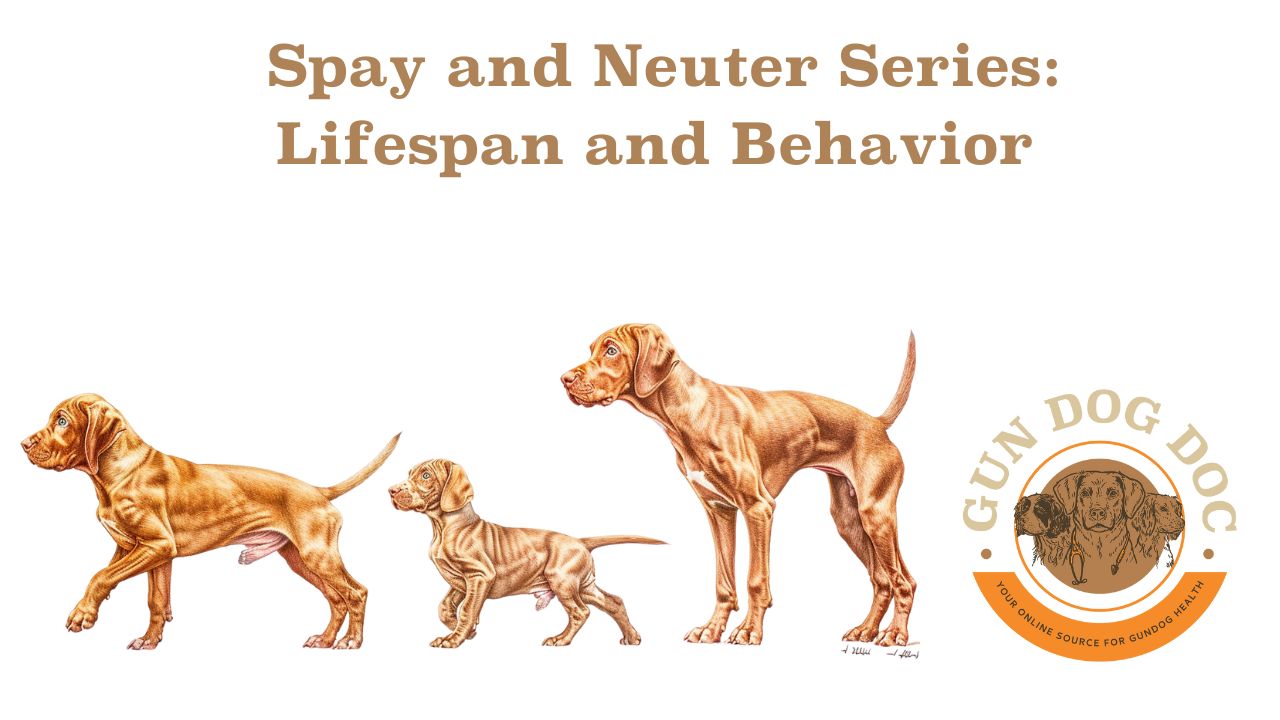This week, we’re diving into some additional intriguing research on the spay/neuter versus intact dog discussion, focusing specifically on lifespan and behavior issues. Let’s explore what the science has to say.
In 2013, a study examined reproductive capability and lifespan in dogs, analyzing 20 years of a medical record data base from over 40,000 dogs—a substantial sample size. The key takeaway is that in this population sterilization is linked to increased lifespan. Interestingly, sterilized dogs are less likely to die from infectious diseases but more commonly die from cancers and immune-mediated diseases. This aligns with our previous discussion on the increased risk of certain cancers due to spaying and neutering, though it’s important to note this risk is specific to certain cancers in certain breeds. For intact dogs, the leading causes of death were infectious diseases and traumatic incidents, likely due to their exposure and potential use in breeding and work. There’s also a hypothesis that increased exposure to progesterone and testosterone, which can be immunosuppressive, plays a role.
However, the study also highlights the limitations of using medical records for research, particularly the socioeconomic implications. Owners who can’t afford spaying/neutering might also struggle to afford later life care for diseases which may skew some of the data.
A popular press headline might simply state, “Neutered and Spayed Dogs Live Longer,” which could be true. However, the authors emphasize the need for more research to understand the physiological consequences of sterilization that impact causes of death and lifespan.
Contrary to this, some breed-specific studies show different results. For example, studies on Rottweilers indicate that males and females neutered before one year have a shorter average lifespan by 1.5 years compared to their intact counterparts. Intact females were three times as likely to live to an extremely old age compared to males, and this benefit disappeared if spayed before age four.
The UC-Davis Hart’s guidelines for Rottweilers, based on 854 cases, recommend neutering after one year and spaying after six months to avoid joint issues observed in early-altered dogs, although no increased cancer risk was noted. Additionally, other studies shows that 25% of Rottweilers neutered before one year developed osteosarcoma, a severe bone tumor requiring amputation.
While Rottweilers aren’t hunting breeds, this data underscores the importance of considering information from various sources when making these decisions.
This discussion might seem contradictory to our previous video, but that’s intentional. The guidelines were based on case numbers from a California teaching hospital, while the Rottweiler studies referenced here come from Western Canada, Michigan, and other databases. Larger scale studies are needed, but for now, it’s crucial to know your breed, your chosen lines, and the reasons dogs in your breed die young.
Behavioral consequences of spaying and neutering have also been studied extensively. One study surveyed over 15,000 dog owners, evaluating aggression towards familiar people, strangers, or other dogs. They found:
- Spay/neuter at any age did not change aggression towards familiar people or dogs.
- Dogs altered between 7-12 months were 26% more likely to show aggression towards strangers, leading to a low but significant increase in moderate to severe aggression across altered categories.
This challenges the historical notion that spaying/neutering curbs aggression.
Looking at hunting breeds, a study on Vizslas examined spay/neuter effects on cancer and behavior, involving 2,505 dogs born between 1992 and 2008. Results showed spayed/neutered dogs had increased odds of developing various cancers and behavioral disorders compared to intact dogs. The younger the age at gonadectomy, the earlier the mean age at diagnosis of these issues.
Behavioral problems were mainly fears and anxieties, like fear of storms and gunshots, and increased arousal, like aggression and hyperactivity. It’s tempting to joke about Vizslas and neurotic behaviors, but it seems some of this reputation could be man-made through spay/neuter decisions.
A more recent survey-based study of over 6,000 dogs examined various reproductive statuses. It found that longer exposure to gonadal hormones, regardless of reproductive status, was associated with reduced odds of general health problems and problematic behaviors, and an increased lifespan.
This presents conflicting information: the first study in this post shows sterilized dogs live longer, while the latter indicates dogs with longer hormone exposure live longer.
Ultimately, there’s no perfect answer. We’re gaining knowledge to inform our decisions, but conflicting information still exists. This is a highly individualized decision with many factors to consider, especially for specific breeds.
In the next post I’ll attempt to distill down all this information and how it might look in a real world discussion. In the last post in the series I’ll summarize my approach to this discussion and share my experiences with my own dogs over the last 25 years, including what I’d do differently today. Stay tuned!
References
- Hoffman JM, Creevy KE, Promislow DEL (2013) Reproductive Capability Is Associated with Lifespan and Cause of Death in Companion Dogs. PLoSONE 8(4): e61082. doi:10.1371/journal.pone.0061082
- Waters, D.J., Kengeri, S.S., Clever, B., Booth, J.A., Maras, A.H., Schlittler, D.L. and Hayek, M.G. (2009), Exploring mechanisms of sex differences in longevity: lifetime ovary exposure and exceptional longevity in dogs. Aging Cell, 8: 752-755. https://doi.org/10.1111/j.1474-9726.2009.00513.x
- Joonè, C.J., Konovalov, D.A. The effect of neuter status on longevity in the Rottweiler dog. Sci Rep 13, 17845 (2023). https://doi.org/10.1038/s41598-023-45128-w
- Ru, G., Terracini, B., & Glickman, L. T. (1998). Host related risk factors for canine osteosarcoma. Veterinary Journal, 156(1), 31-39. doi:10.1016/S1090-0233(05)80058-0
- Farhoody P, Mallawaarachchi I, Tarwater PM, Serpell JA, Duffy DL and Zink C (2018) Aggression toward Familiar People, Strangers, and Conspecifics in Gonadectomized and Intact Dogs. Front. Vet. Sci. 5:18. doi: 10.3389/fvets.2018.00018
- Zink, M. C., Farhoody, P., Elser, S. E., Ruffini, L. D., Gibbons, T. A., & Rieger, R. H. (2014). Evaluation of the risk and age of onset of cancer and behavioral disorders in gonadectomized Vizslas. Journal of the American Veterinary Medical Association, 244(3), 309-319. https://doi.org/10.2460/javma.244.3.309
- Zink, C., Delgado, M. M., & Stella, J. L. (2023). Vasectomy and ovary-sparing spay in dogs: comparison of health and behavior outcomes with gonadectomized and sexually intact dogs. Journal of the American Veterinary Medical Association, 261(3), 366-374. https://doi.org/10.2460/javma.22.08.0382



